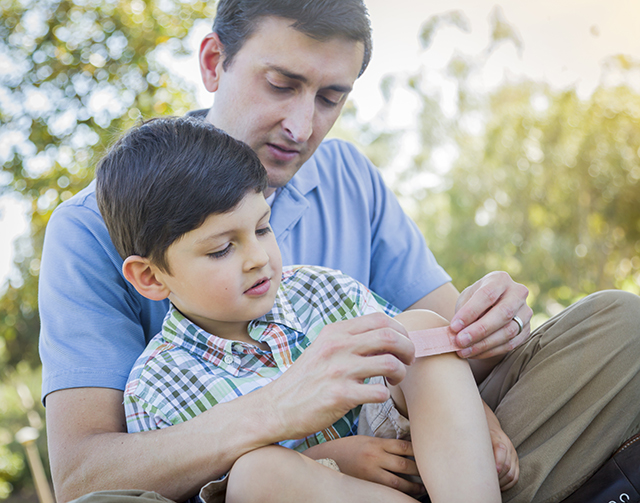When you’re scrambling to make a burn feel better or find an antidote for someone who has mistakenly swallowed a poisonous chemical, you might fall back on some of the folklore of first aid. Rather than helping, these common first aid mistakes can actually make matters worse. Here are a few common first aid falsehoods and what you should do instead.
Mistake: Putting butter on a burn.
You’ve probably heard the tip to put butter on a burn, but bear in mind that it’s bad advice: Any greasy substance on a burn keeps heat in and could make it hard for a burn to heal or be properly treated.
What to do: Run cold water over the burn to ease the pain. Then gently dry the area and keep it loosely covered. If it starts to blister, becomes discolored, or seems infected, get medical treatment.
Mistake: Using syrup of ipecac to cause vomiting.
When someone swallows a poisonous chemical, you might think to bring it back up immediately. Syrup of ipecac has been discontinued and should NOT be used. In some cases of poisoning, experts say it’s best not to induce vomiting, which can cause more damage. Some substances actually can be worse for you when they are vomited up again.
What to do: Immediately call your healthcare provider or the national Poison Control Center (800-222-1222) for advice about handling the situation.
Mistake: Putting heat on a sprain or fracture.
Heat can be soothing for aches and pains, but you shouldn’t apply heat to a sprain or fracture. Heat will only increase the swelling.
What to do: Apply ice, an ice pack or even frozen veggies for about 20 minutes. Make sure to wrap the ice in a towel to protect your skin. Use the RICE treatment of Rest, Ice, Compression, Elevation.
Mistake: Putting hot water on frozen skin.
You might be tempted to run hot water over a frozen patch of skin or a limb to warm it up. This approach increases the risk of damaging skin if you use water that is too hot.
What to do: Gradually thaw the skin or limb with a warm — not hot — water bath.
Mistake: Using rubbing alcohol to bring down a fever.
Wiping rubbing alcohol on your skin makes your skin feel cooler, but this cooling doesn’t help that much when you have a fever. In addition, alcohol can be soaked up through the skin. For small children and infants in particular, this approach increases the risk of alcohol poisoning.
What to do: Try a medicine that reduces fever containing ibuprofen or acetaminophen. Call your healthcare provider if the fever doesn’t go away.
Mistake: Using a tourniquet for a snakebite.
Tying off the flow of blood to prevent the spread of poisons from a snakebite seems like a wise idea, but might just cause more damage. In some cases, the poison is then concentrated in one area where it can be damaging. In other cases, damage happens with the sudden release of snake venom into the blood once the tourniquet is taken off.
What to do: The most important step is to calm the person who was bitten. Help him or her to keep the bitten body part completely still to slow the flow of venom in the body. Since swelling can become severe, remove jewelry and constricting clothing from areas near the bite. Antivenin is the most effective treatment for most poisonous snakebites, but this is a complicated situation that needs expert treatment. Get emergency medical aid as quickly as possible.
Mistake: Using a tourniquet to stop a bleeding wound.
For a deep wound in an arm or leg, you may think about tying a tourniquet around the thigh or upper arm to stop the bleeding. But that could stop the flow of blood to the entire limb, causing more damage.
What to do: Apply direct downward pressure on the wound (use a thick layer of sterile gauze under your hands if it’s available), and then wrap the wound securely when the bleeding stops. If it continues to bleed or appears to need stitches, seek medical care.
Mistake: Rubbing your eye to remove a foreign object.
When you have a speck of dirt or some other debris in your eye, the feeling can be extremely aggravating. Although you may want to rub your eye to remove the debris, hold back from rubbing your eye. Rubbing your eye when there is a foreign object in it can cause more damage to your eye.
What to do: Since tears alone probably won’t be enough to wash out the debris, rinse your eye with clean tap water. Get medical care if the feeling continues.
Mistake: Leaving an adhesive bandage on a cut.
Putting antibacterial ointment on a cut and then leaving on a bandage for a few days doesn’t speed healing. Doing this increases unwanted moisture over the cut.
What to do: Clean the cut and apply ointment, but then let it heal in the fresh air. If you need a bandage to keep the cut clean, make sure you change it about twice a day. Also, keep the entire area clean and dry by using gentle soap and water when changing the bandage.

